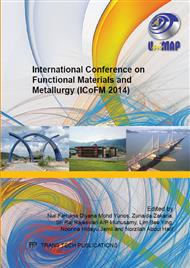p.31
p.39
p.45
p.50
p.57
p.63
p.71
p.76
p.81
Effect of Filler Metals on the Microstructures and Mechanical Properties of Dissimilar Low Carbon Steel and 316L Stainless Steel Welded Joints
Abstract:
In this paper, dissimilar joining of 316L stainless steel to low carbon steel was carried out using gas metal arc welding (GMAW) and gas tungsten arc welding (GTAW). Samples were welded using AWS: ER309L welding electrode for GMAW and AWS: ER316L welding electrode for GTAW process. Determination of mechanical properties and material characterization on the welded joints were carried out using the Instron tensile test machine and an optical microscope respectively. The cross section area of the welded joint consists of three main areas namely the base metal (BM), heat affected zone (HAZ), and weld metal (WM). It was found that, the yield and tensile strengths of welded samples using ER316L filler metal were slightly higher than the welded sample using ER309L welding electrode. All welded samples fractured at low carbon steel base metal indicating that the regions of ER316L stainless steel base metal, ER316L filler metal and heat affected zone (HAZ) have a higher strength than low carbon steel base metal. It was also found that ER316L welding electrode was the best filler to be used for welding two dissimilar metals between carbon and stainless steel.
Info:
Periodical:
Pages:
57-62
Citation:
Online since:
June 2015
Authors:
Keywords:
Price:
Сopyright:
© 2015 Trans Tech Publications Ltd. All Rights Reserved
Share:
Citation:


